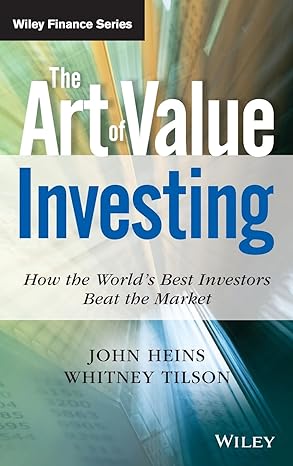Overview : The Art of Value Investing: How the World's Best Investors Beat the Market
-
Book Title: The Art of Value Investing: How the World's Best Investors Beat the Market
-
Author: John Heins and Whitney Tilson
-
Publication Date: April 16, 2013
-
Rating: 4.5
-
price: $23.69
-
Pages: 336
About the Author
John Heins is the co-founder and President of Value Investor Media, Inc. Whitney Tilson is the founder and Managing Partner of Kase Capital Management. In conclusion, this article has provided an overview of the topic at hand.
Introduction
In the ever-evolving world of finance and investing, few strategies have stood the test of time like value investing. John Heins and Whitney Tilson's "The Art of Value Investing" offers a masterclass in this timeless approach, drawing wisdom from some of the most successful investors in history. This comprehensive review explores the book's insights, its relevance in today's market, and why it's a must-read for both novice and experienced investors alike.
Book Summary and Key Themes
"The Art of Value Investing" is not just another how-to guide on stock picking. Instead, it's a deep dive into the philosophy and mindset that drive successful value investors. Through a series of interviews with over 40 renowned investors, including Seth Klarman and Joel Greenblatt, Heins and Tilson uncover the core principles that have led to their success in the financial markets.
Key themes explored in the book include:
- The importance of patience and discipline in investing
- Strategies for identifying undervalued stocks
- Risk management techniques
- The role of contrarian thinking in value investing
- Adapting value investing principles to changing market conditions
Analysis of Core Concepts
Intrinsic Value and Margin of Safety
At the heart of value investing lies the concept of intrinsic value. The book emphasizes the importance of looking beyond market prices to determine a company's true worth. This approach, pioneered by Benjamin Graham and championed by Warren Buffett, forms the foundation of the value investing strategy.
Closely tied to intrinsic value is the principle of margin of safety. As one featured investor notes, "The margin of safety is the difference between the intrinsic value of a stock and its market price." This buffer protects investors from downside risk and potential errors in valuation.
Contrarian Thinking and Market Inefficiencies
Heins and Tilson highlight how successful value investors often go against the grain of popular opinion. By identifying market inefficiencies and mispriced securities, these investors can capitalize on opportunities that others may overlook. This contrarian approach requires both courage and thorough analysis, themes that resonate throughout the book.
Writing Style and Accessibility
The authors present complex financial concepts in a clear, engaging manner. By structuring the book around investor interviews, they provide real-world context to theoretical principles. This approach makes "The Art of Value Investing" accessible to readers with varying levels of financial expertise.
However, some readers might find the interview-based format less cohesive than a traditional narrative. While this structure offers diverse perspectives, it occasionally lacks a unified voice.
Strengths and Weaknesses
Strengths:
- Rich insights from successful investors
- Comprehensive coverage of value investing principles
- Practical advice for applying concepts to real-world scenarios
- Timeless wisdom that transcends market cycles
Weaknesses:
- May be challenging for absolute beginners
- Interview format can sometimes feel disjointed
- Limited coverage of newer investment trends like cryptocurrencies
Comparison to Other Works
While "The Art of Value Investing" shares similarities with classics like Benjamin Graham's "The Intelligent Investor," it offers a more contemporary perspective. Unlike more theoretical texts, this book provides insights into how modern investors apply value principles in today's complex markets.
Compared to trend-focused investment books, Heins and Tilson's work emphasizes enduring strategies rather than short-term tactics. This approach aligns more closely with long-term wealth building than with quick profit schemes.
Relevance in Today's Market
In an era of algorithmic trading and high-frequency transactions, the principles outlined in "The Art of Value Investing" remain remarkably relevant. As markets become increasingly volatile, the book's emphasis on thorough analysis and patient investing provides a stabilizing framework for investors.
The book's teachings are particularly pertinent in light of recent market trends. For instance, the rise of meme stocks and cryptocurrency speculation underscores the importance of understanding intrinsic value and maintaining a long-term perspective.
Highlights from The Art of Value Investing: How the World's Best Investors Beat the Market
Value Investing Philosophy: Focuses on buying undervalued stocks with strong fundamentals and long-term potential.
Margin of Safety: Always invest with a buffer to protect against market volatility and unforeseen risks.
Understanding Businesses: Invest in companies you deeply understand, including their business models, competitive advantages, and risks.
Long-Term Perspective: Prioritize long-term gains over short-term market fluctuations, avoiding impulsive decisions.
Patience and Discipline: Successful investing requires patience and the discipline to stick to your strategy during market downturns.
Continuous Learning: Stay updated on market trends and company performance to refine your investment approach.
Conclusion and Recommendation
"The Art of Value Investing" is a valuable addition to any investor's library. Its blend of timeless wisdom and practical advice makes it an essential read for those looking to develop a robust investment strategy. While it may require some foundational knowledge to fully appreciate, the insights gained are well worth the effort.
For investors seeking to navigate the complexities of today's financial markets, this book offers a compass guided by the collective wisdom of some of the industry's most successful practitioners. Whether you're building a personal finance strategy or managing a professional portfolio, the principles outlined in "The Art of Value Investing" provide a solid foundation for long-term success.
Ready to master the art of value investing?





